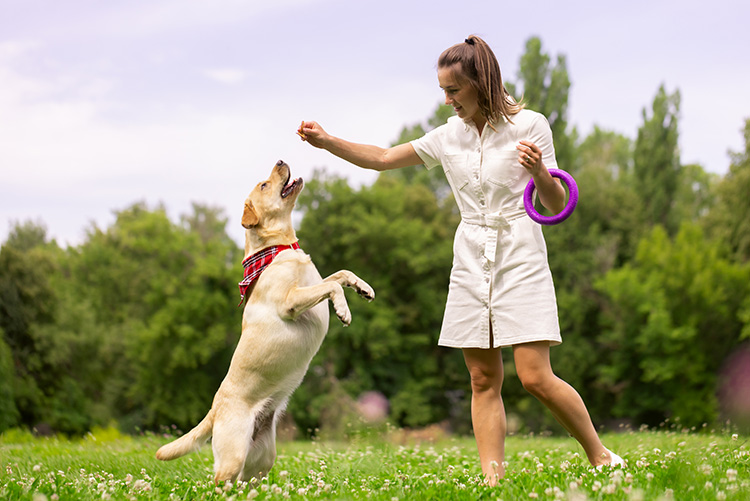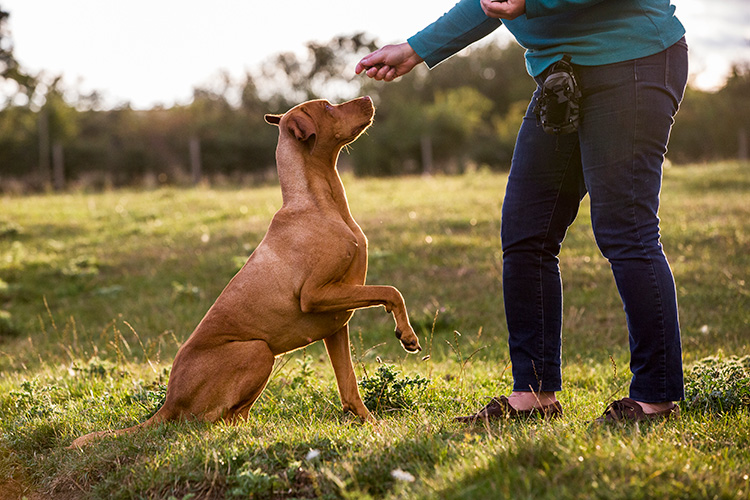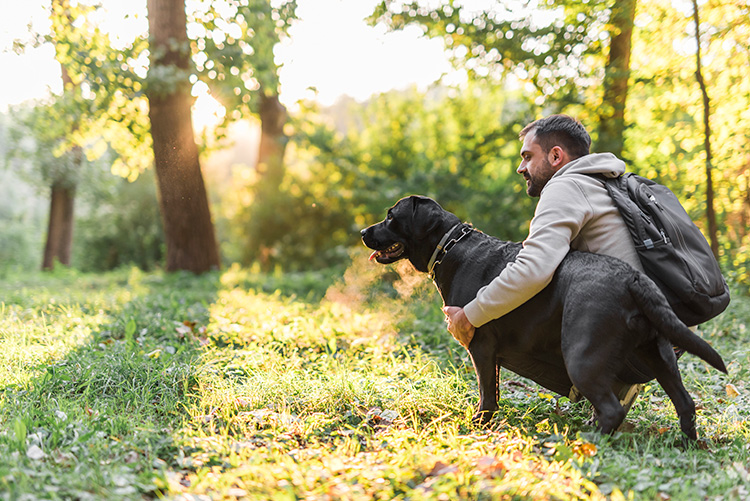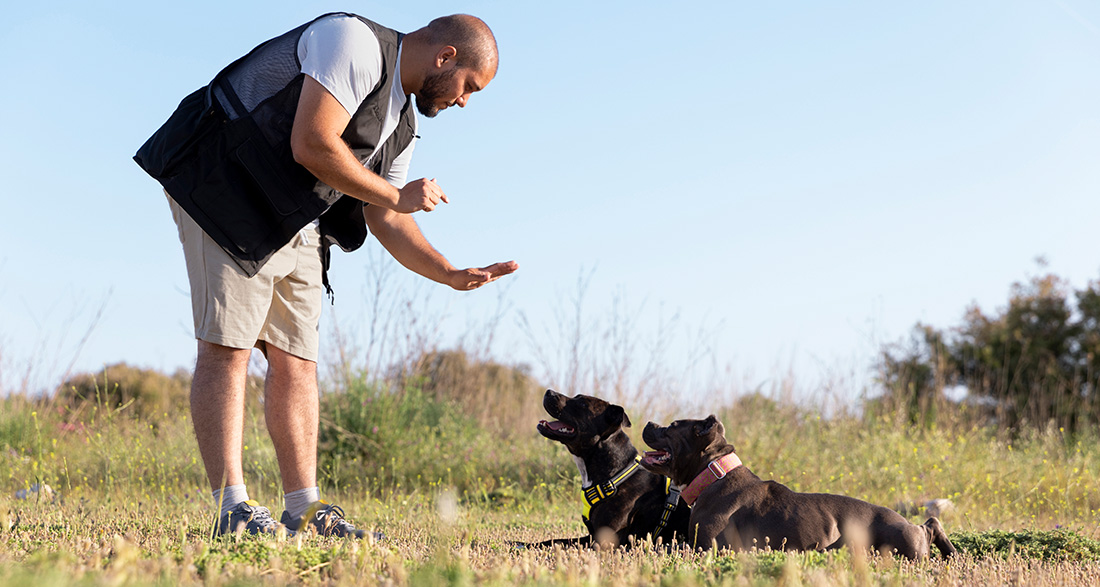Dog training is a lengthy process. Does my dog really need to go to a dog school?
Similar to children, dogs are trainable. These animals require a leader, and as an owner, you need empathy and a lot of patience. However, you should also be able to set boundaries for your dog.
Prerequisites: Training a Dog Without a Dog School
Whether you can train your canine companion without attending a dog school depends on various factors—both on your part and your pet’s. Dogs can vary greatly in character and personality.

Even before getting a dog, you can consider many things to create suitable conditions for home training. Comprehensive research on different breeds is essential. Assess whether the four-legged friend fits into your life circumstances. Can you provide the engagement, time, care, and living conditions the animal needs? Experience and knowledge of dogs and dog training are also advantageous.
Generally, every dog can be trained, but some breeds are easier to train than others. Dogs are categorized into working and companion dogs. Companion dogs (Labrador, Golden Retriever) are usually easier to train as they were primarily bred as pets. Working dogs (Dachshund, Weimaraner), such as hunting or herding dogs, usually require a lot of activity and possess a certain independence. Experienced dog owners typically handle this characteristic tendency better than beginners.

The age of the dog also plays a role in determining whether it should attend a dog school or be trained by the owner. If you get a puppy, you can often successfully handle its training yourself. Experience in dog training is beneficial in this case. If you acquire an older dog, issues like bad manners may arise. Without professional trainers, it can be challenging to address these problems. Whether a puppy or an adult dog, the right training is crucial at every stage of life.
In essence, providing appropriate mental stimulation and teaching commands are vital prerequisites for training a dog without attending a dog school. However, if you opt for a training school, don’t wait until major problems arise. It’s much more challenging to correct behavioral issues retroactively than to proactively prevent them.
What Dogs Learn in a Dog School
A good dog school aims to enhance communication between humans and dogs, as well as the dogs’ social behavior with each other. This fosters the dog’s integration into the family as a seamless member.
The dog should also learn various commands, with the trainer effectively conveying these to the owner. Common commands such as “Sit!”, “Down!”, or “Heel!” should be second nature to your dog. These commands are crucial for simplifying daily interactions between you and your pet.
The interaction with other dogs also plays a significant role. It positively influences social behavior and serves as an important learning process. Contact with other canines can prepare dogs for future situations and challenges in everyday life.
Most dog schools offer different courses or classes tailored to age or inclination. Even at a young age, puppies can get to know their peers.
How to Find the Right Dog School
Finding a good dog school is not easy, as the term is not subject to any regulatory or legal requirements in the US. Anyone can call themselves a dog trainer or a dog school. Therefore, pay special attention to the selection of your dog school and its methods.
Checklist for finding a good dog school:
- Free consultation before training begins.
- Opportunity to observe a training session without a dog.
- Trainer with extensive experience.
- Trainer regularly undergoes further education.
- Training takes place in a pleasant, stress-free atmosphere. Commands are given calmly and friendly.
- Training (almost) without treats, so the dog focuses on the person rather than treats.
- Small groups, ideally six to eight participants.
- Training sessions are not too long, allowing the dog to leave with a positive feeling.
- Emphasis on praise and affection. Yelling and violence have no place in a good dog school.
- Individual and concrete solutions for addressing problems.
- Focus on the well-being of both the human and the dog, not on ambition or athletic achievements.
- Individualized training for the dog.
- A wide range of courses (individual training, group training, training outside the dog school, etc.).
Your gut feeling is crucial. Don’t let anything be imposed on you. However, the most important indicator is your dog. Does your dog seem excited about training, or does it appear tense after leaving the dog school?

Tips for Dog Training
Dog training is an important topic that concerns every dog owner. To make living with your four-legged companions work, certain rules are necessary. The dog must also learn how to behave in traffic, in crowded places, or with other animals. The following tips will make the training process with your dog easier.
Need for Rules
It makes sense to find a healthy balance in the rules you want to instill in your dog. Too many rules can overwhelm the animal to the point where it shuts down and refuses to cooperate. It’s crucial to give clear instructions to the dog so that it accepts you as the pack leader. Rules related to safety in traffic or other challenging situations should definitely be taught. Additionally, certain guidelines for cohabitation are essential. Therefore, teach your dog early on what is allowed and not allowed in the home to minimize conflicts.
Age-Appropriate Dog Training
To make training methods successful, your dog’s age should be taken into account. Puppyhood is a playful time, and they should learn a lot during this period. Try to keep training sessions and learning phases short during this age. During puberty, dogs are often inattentive due to changing character traits. It’s crucial to be patient and consistent during this phase. Once dogs reach adulthood, they have established personalities that you should respect. They have rules and preferences that you should acknowledge. Older dogs are often more challenging to train.
Stay Consistent
Similar to raising children, it’s important to remain consistent in your dog training, even when it gets tough. Once you’ve established rules, your dog will only accept them if you show that you mean business. Hunting dogs or dominant dogs require consistent owners, as inconsistency can eventually lead to fearfulness or aggression. Therefore, it’s crucial to establish yourself as a leader.
Rewards Instead of Violence
Dog training involves working with positive and negative associations. Desired behavior is rewarded, and negative behavior is rejected. By rewards, we don’t mean constantly feeding treats but rather praise or affection.
Undesirable behavior should never be addressed with violence. You can communicate your disapproval through your behavior or firm commands. If misbehavior persists or becomes chronic, consult a professional. They can provide advice on how to restore harmony between humans and animals.
Conclusion
Training a dog at home is indeed possible if certain conditions are met. However, it’s important to trust your instincts. If you notice that your dog doesn’t understand you and you’re at a loss, seek help from a professional. Don’t be afraid to ask for assistance if you’re out of ideas.


